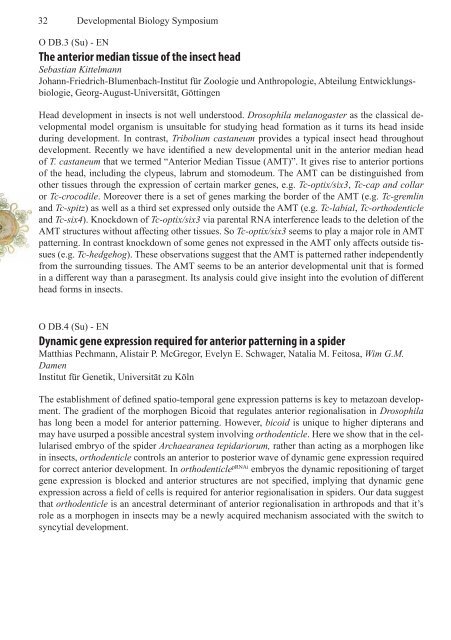Abstracts - Deutsche Zoologische Gesellschaft
Abstracts - Deutsche Zoologische Gesellschaft
Abstracts - Deutsche Zoologische Gesellschaft
You also want an ePaper? Increase the reach of your titles
YUMPU automatically turns print PDFs into web optimized ePapers that Google loves.
32 Developmental Biology SymposiumO DB.3 (Su) - ENThe anterior median tissue of the insect headSebastian KittelmannJohann-Friedrich-Blumenbach-Institut für Zoologie und Anthropologie, Abteilung Entwicklungsbiologie,Georg-August-Universität, GöttingenHead development in insects is not well understood. Drosophila melanogaster as the classical developmentalmodel organism is unsuitable for studying head formation as it turns its head insideduring development. In contrast, Tribolium castaneum provides a typical insect head throughoutdevelopment. Recently we have identified a new developmental unit in the anterior median headof T. castaneum that we termed “Anterior Median Tissue (AMT)”. It gives rise to anterior portionsof the head, including the clypeus, labrum and stomodeum. The AMT can be distinguished fromother tissues through the expression of certain marker genes, e.g. Tc-optix/six3, Tc-cap and collaror Tc-crocodile. Moreover there is a set of genes marking the border of the AMT (e.g. Tc-gremlinand Tc-spitz) as well as a third set expressed only outside the AMT (e.g. Tc-labial, Tc-orthodenticleand Tc-six4). Knockdown of Tc-optix/six3 via parental RNA interference leads to the deletion of theAMT structures without affecting other tissues. So Tc-optix/six3 seems to play a major role in AMTpatterning. In contrast knockdown of some genes not expressed in the AMT only affects outside tissues(e.g. Tc-hedgehog). These observations suggest that the AMT is patterned rather independentlyfrom the surrounding tissues. The AMT seems to be an anterior developmental unit that is formedin a different way than a parasegment. Its analysis could give insight into the evolution of differenthead forms in insects.O DB.4 (Su) - ENDynamic gene expression required for anterior patterning in a spiderMatthias Pechmann, Alistair P. McGregor, Evelyn E. Schwager, Natalia M. Feitosa, Wim G.M.DamenInstitut für Genetik, Universität zu KölnThe establishment of defined spatio-temporal gene expression patterns is key to metazoan development.The gradient of the morphogen Bicoid that regulates anterior regionalisation in Drosophilahas long been a model for anterior patterning. However, bicoid is unique to higher dipterans andmay have usurped a possible ancestral system involving orthodenticle. Here we show that in the cellularisedembryo of the spider Archaearanea tepidariorum, rather than acting as a morphogen likein insects, orthodenticle controls an anterior to posterior wave of dynamic gene expression requiredfor correct anterior development. In orthodenticle pRNAi embryos the dynamic repositioning of targetgene expression is blocked and anterior structures are not specified, implying that dynamic geneexpression across a field of cells is required for anterior regionalisation in spiders. Our data suggestthat orthodenticle is an ancestral determinant of anterior regionalisation in arthropods and that it’srole as a morphogen in insects may be a newly acquired mechanism associated with the switch tosyncytial development.

















